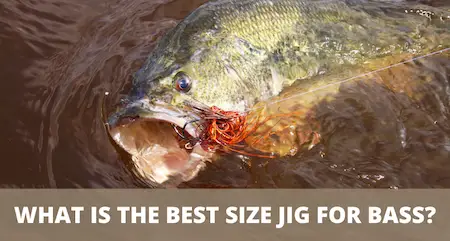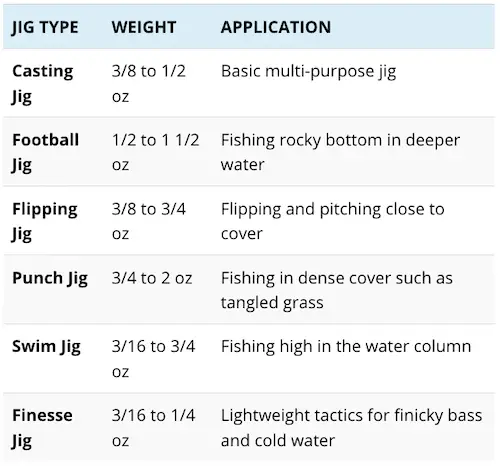What Is The Best Size Jig For Bass? (Complete Guide)
UPDATED 03 NOVEMBER 2023
by Robert Ceran
Jigs are among the most effective and versatile bass lures available today, and produce more fish than almost any other bait.
The only problem is that they come in a bewildering variety of shapes and sizes, each of which is designed to perform best in different conditions.
So in order to get the best results when jig fishing for bass, it’s essential to understand not only what type of jig you should be using in what situation, but also what size.

In this article we’ll go over the most important bass jigs, and discuss what sizes you should choose for each of them.
What size jig should you use for bass?
The best all around size for bass jigs is 3/8 to 1/2 oz. But if you’re fishing in deep water, or in heavy cover, you can increase the size up to 2 oz, and if you’re throwing a finesse jig, you can reduce the weight down to 3/16 oz.
Different types of bass jigs are designed for different situations, ranging from open water to thick cover, and from 3 feet of water to 50 foot deep water.
And obviously the best size to use depends on the conditions you plan to fish in.
So in this article we’ll cover the 6 most important types of bass jigs, and discuss what sizes perform best for each of them.
Bass jig size chart
| JIG TYPE | WEIGHT | APPLICATION |
|---|---|---|
| Casting Jig | 3/8 to 1/2 oz | Basic multi-purpose jig |
| Football Jig | 1/2 to 1 1/2 oz | Fishing rocky bottom in deeper water |
| Flipping Jig | 3/8 to 3/4 oz | Flipping and pitching close to cover |
| Punch Jig | 3/4 to 2 oz | Fishing in dense cover such as tangled grass |
| Swim Jig | 3/16 to 3/4 oz | Fishing high in the water column |
| Finesse Jig | 3/16 to 1/4 oz | Lightweight tactics for finicky bass and cold water |
The jig weight size chart above shows the recommended weights for the most important types of bass jigs, as well as the fishing application for which they are each ideally suited.
Now let’s look at each of these jigs more closely, to get a better understanding of what weight you should use for each of them.
Casting jig: designed as a basic multi-purpose jig that can work well for many standard applications. Its most characteristic feature is the flat bottom jig head, which allows it to rest on the bottom with the tail sticking upwards.
Sizes range from 3/8 to 1/2 oz, and this is the best all around size range to use for most standard jigging applications.
Football jig: designed for fishing for offshore bass on rocky bottom in deeper water between 10 and 50 feet deep. The size range is from 1/2 to 1 1/2 oz.
Choose the weight according to the depth you want to fish in – the deeper the water, the heavier it should be. Also, the more wind and current you encounter, the heavier your jig should be.
Flipping jig: designed for making short casts by flipping or pitching close to dense cover. The size range is from 3/8 to 3/4 oz.
Choose the weight according to how thick the cover is that you need to penetrate, and also according to the fall rate you need to achieve. Since the fall rate is critical for this technique, you should also test different trailers to dial it in perfectly.
Punch jig (grass jig): designed with an oversized lead or tungsten head to penetrate the densest vegetation, including tangled grass beds and laydowns.
The size range is from 3/4 to 2 oz, and depends on how thick the cover is that you need it to break through. It comes with a thick weed guard that is sometimes doubled to protect it from getting snagged, making it the perfect choice for fishing heavy cover.
Swim jig: designed to be fished higher in the water column than other jigs (more like a spinnerbait or chatterbait). Its size ranges from 3/16 to 3/4 oz, and should be chosen according to how high in the water column you want to fish it – the higher, the lighter it should be.
You can also use it to fish dense areas of submerged grass, in which case it’s better to choose a heavier jig to penetrate the dense vegetation.
Finesse jig: as the name suggests, designed for lightweight fishing tactics. A great choice for finicky bass, and also works well when the water is cold, as the bass become more sluggish, and slow lure retrieval works better.
The size range is from 3/16 to 1/4 oz. Choose the weight according to the water depth, and how slow you want to make your retrieve – the lighter, the slower you can fish it.
Best all around jig sizes for bass
The best all around jig sizes for bass range from 3/8 to 1/2 oz. These sizes are right in the middle of the range, and work well for many different scenarios.
So if you’re new to bass fishing, or fishing a new lake or river for the first time, it’s best to start with these sizes. Then, if you don’t get a lot of bites, experiment with upsizing or downsizing your jigs according to the conditions you’re fishing in.
Jig weight and water depth
As you might expect, heavier jigs are better for fishing deep water, since they sink faster to the bottom, and it’s easier to keep them on the bottom during retrieval.
That’s why football jigs are often on the heavier side, since they are intended to be fished in deeper offshore areas of lakes.
On the other hand, if you’re fishing in shallow water with no cover, a lighter jig is often a better choice, since it allows you to slow down the retrieve rate, and to keep your lure longer in the strike zone.
Effect of jig size on fall rate
Another factor to consider is the fall rate of your jig (which refers to how quickly it falls to the bottom after you pull it up with your rod).
A jig with a heavy head falls more quickly than a light one, and this is an important factor because bass usually bite your lure while it’s falling, and so you’ll want to choose the ideal fall rate for triggering the most bites.
Depending on the situation you’re fishing in, it can be better to aim for a slower or faster fall rate. When bass are feeding aggressively, it’s generally best to use the heaviest jig you can get away with, as that allows you to work the jig faster, and cover more water.
On the other hand, if the bass are finicky, it’s often better to slow things down, and to use a lighter jig, or even switch to a finesse jig.
Keep in mind that another way to adjust the fall rate is by using a bigger, bulkier trailer that generates more resistance in the water. That way you can sometimes work with a heavier jig, but still get a slow enough fall rate to trigger bites.
Choosing the right size jig for heavy cover
Some of the best bass fishing spots during the summer are right in the middle of dense cover, such as lily pads, grass beds, or thick growths of water weeds that reach all the way to the water surface, forming what many bass anglers affectionately call “the slop.”
If you want to have a chance of penetrating this kind of dense vegetation with your jig, and of getting it to fall down into the water between the plants, you need to use larger jig sizes, from 3/4 oz all the way up to 2 oz.
Best jig size for finicky bass
When the bass bite is slow, or if you notice that they’re just swiping at the trailer of your jig without eating it properly, it can be very effective to switch to a smaller, lighter jig, ranging from 3/16 oz to 1/4 oz.
There are two reasons for this: you can slow down the retrieve rate with a smaller jig, and it also has a slower fall rate in the water. That gives finicky bass more time to commit to eating it, resulting in more bites.
This also applies when water temperatures drop below 60 to 65 degrees, as bass become more sluggish in cold water, and will not chase a fast lure.
If you’re currently in the market for a bass jig rod, check out our article on what is the best bass jig rod?
Jig size chart

